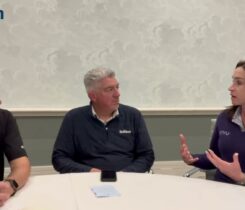Off the Record: Changing nematode management
In 1990, the USGA Green Section started investigating what happens to pesticides and fertilizer applied to golf course turfgrass. We did not know what to expect from the research results but maintained an honest reporting of the results.
Projects started in 1991, by George Snyder, Ph.D., and John Cisar, Ph.D., focused on investigating the mobility and persistence of organophosphate (OP) pesticides in a USGA green. The groundwork for this study involved installing lysimeters in a Tifdwarf bermudagrass USGA green at the Ft. Lauderdale Research and Education Center (FLREC). Analytical methods were developed at the Pesticide Lab in Belle Glade, Fla., to determine OP pesticides in soil, thatch, plant tissue and water moving through the green (e.g., percolate).
By 1993, Snyder and Cisar completed studies on OP-pesticide losses in percolate, soil and thatch retention, and clipping removal. The pesticides studied included fenamiphos (Nemacur), fonofos (Dyfonate), chlorpyrifos (Dursban), isazophos (Triumph), isofenphos (Oftanol) and ethoprop (Mocap). They found less than 0.2 percent of the applied pesticide in percolated water and less than one percent in clippings.
These results were good news, but leaching was more significant for the sulfoxide-sulfone metabolite of fenamiphos and chlorpyrifos recovery in clippings exceeded seven percent for a granular application. However, most of the applied OP pesticides seemed to be retained in the thatch layer, undergoing microbial degradation over time.
Snyder and Cisar found the residues of fenamiphos and fonofos to reside primarily in the thatch layer. In contrast, the sulfoxide+sulfone metabolites were in the soil to a greater degree. Also, they observed a considerable amount of the metabolite in percolated water, especially following the first application of fenamiphos.
An average of 17.7 percent of the applied fenamiphos was found as metabolites in the percolated water following the first application, whereas there was only 1.1 percent after the second application. They believed the difference was due to increased microbial degradation after the first application.
Nevertheless, both percentages are high relative to the fenamiphos parent compound or fonofos, for which a maximum of 0.06 and 0.02 percent of applied were obtained in percolated water following any one application. Excessive irrigation appeared to contribute to the leaching of fenamiphos metabolites.
They could remove less than one percent of diazinon, chlorpyrifos and isazophos applied to a bermudagrass green onto cotton cloth rubbed on the surface immediately after pesticide application. However, after a 0.2-inch irrigation, dislodgeability increased to approximately 15 percent of the pre-irrigation measurement. 24 hours after application, about three percent of the pesticide was dislodged compared to the immediate post-application measurement.
The Results
Collaborating with the University of Florida Center for Environmental and Human Toxicology, Snyder and Cisar made a preliminary pesticide risk assessment analysis based on dislodgeability data collected in their experiments. The analysis suggested that exposure to diazinon, chlorpyrifos and isazophos, even in a worst-case scenario, would be below the acceptable limits the EPA set.
Snyder and Cisar published dozens of publications and presentations on their research, contributing valuable insights into the mobility, retention and potential risks associated with organophosphate pesticides in golf course environments. Unfortunately, soon after this research, Nemacur became unavailable for nematode control on golf courses.
John Rowland, Ph.D., agronomist, USGA Green Section, provides current information on dealing with nematode problems on golf courses in this issue.
Bionematicides, such as Zelto and Crescendo, should be applied around nematode egg hatching and chemical nematicides are used afterward if conditions warrant. Rowland lists the current chemical nematicides, their different chemical classes and their efficacy on specific nematode species.












